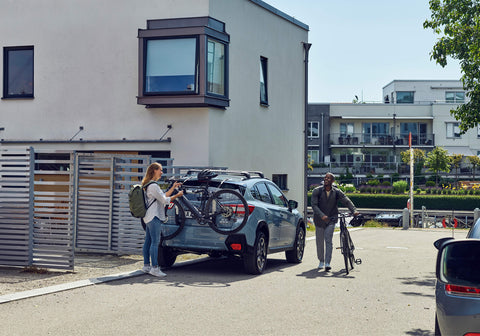Bike Racks
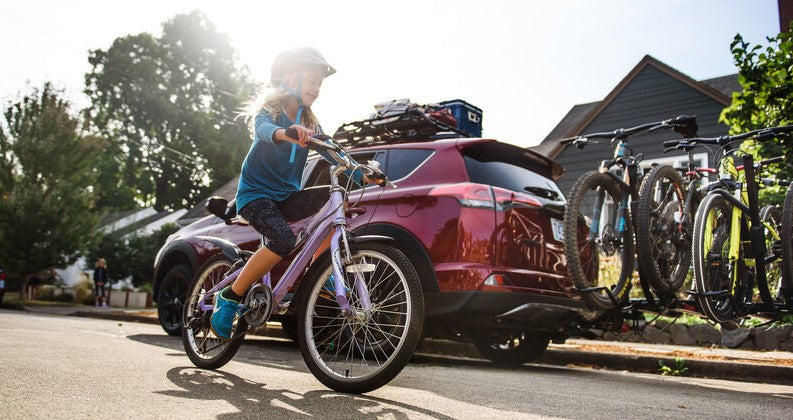
There are loads of bike racks and carriers on the market. Finding one that suits your bikes, lifestyle, and budget will ensure you are happy with your purchase and get many years of useful service from your rack. You also need to consider how the rack will attach to your vehicle. This is not just about the suitability of your vehicle, but also how easy it is to load and unload your bike. Here is a guide to help you work through what it is that you need from your bike carrier.
Top-of-car or rear-of-car?
Broadly, there are two main areas on a vehicle suitable for carrying bikes. On the roof or on the rear of the vehicle. There are positives and negatives to both, the goal is to work out what suits your needs best.
Top-of-car
The main advantage of top-of-car mounts is that it leaves you clear access to the rear trunk/boot of your vehicle. You will need to have roof racks installed on your vehicle to do this which adds cost to your set up. It’s a flexible option in terms of how many bikes you can have. Depending on the size or width of your vehicle you could have 1 or up to 5 racks on your roof. This can get quite costly once you add up installing the roof racks then purchasing individual racks for each bike.
When it comes to mounting your bike on a rooftop bike carrier there are also options here. Do you want to mount your bike with the front wheel off? Or would you prefer the convenience of a wheel-on solution? Taking the front wheel off and mounting the bike by the fork brings the overall height down - great if you regularly park in parking garages but it does require more preparation. Wheel-off is generally considered the most secure mount as well. Wheel-on mounts grip your bike by either the frame or by the wheels. If you have an extra-large or small bike - there might not be a solution to fit your bike so you might go for a frame grab.
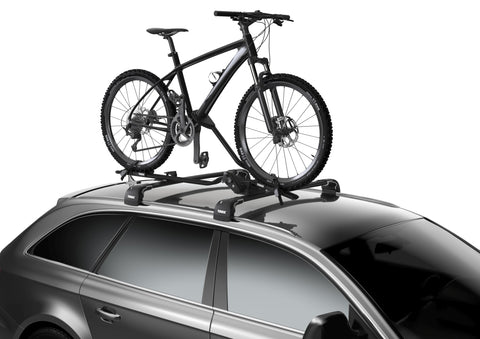
Advantages:
- Leaves free and clear access to your boot/trunk
- Customisable to the number of racks/bikes you need
- Installing roof racks may have benefits for other activities
- Fork mount and wheel-grab options are the best when your bike frame is made from carbon-fiber.
- Easy to leave on roof racks in-between uses so no need to store and re-fit each time you use them
- You can combine with a roof box or other accessories like a kayak once you have roof racks.
Disadvantages:
- Need to install roof racks
- Watch for clearance under parking garages
- Having more than two bikes on your roof makes access difficult for the middle mounted bikes.
- Will affect your fuel consumption by creating drag
- Limited by the weight carrying capacity of your vehicle’s roof. You must add up the weight of your load including bikes, plus carriers, plus roof racks, and compare them to the manufacturer’s recommendations.
Considerations:
- How do you want the bike to be held - by the wheel or frame?
- Do you have a large 4x4? Reaching and lifting the bikes to load & unload could be an issue.
- If you have a sunroof/moonroof on your vehicle - it may be incompatible with the options available
Rear-of-car
There are plenty of options to work through on Rear-of-car mounts as well. The clear advantage is not having to lift the bikes overhead for mounting, and in some cases, you can even purchase a compatible ramp to drive up bikes and
save the heavy lifting. You may not need to purchase roof racks but you might need a tow ball or hitch receiver instead. There are options available to mount directly onto the boot of a vehicle but this will limit the number of bikes you can carry safely.
Rear-of-car racks will almost definitely hinder the view of your number plate so check with your local authority on what the regulations are in your area to avoid being fined. You may need to purchase an accessory number plate and holder or even a lightboard depending on regulations in your state.
Strap Rack Bike Racks
These racks mount directly to the back of your hatch, wagon or sedan using straps and hooks to grip onto the back of your vehicle. Generally, you can carry up to 3 bikes at a time. The bikes will be secured by the frame.

Advantages:
- Low-cost option
- Usually easy to fold away and store between uses
Disadvantages:
- No access to the trunk/boot while in use
- Needs adjustment for a secure fit every time you re-fit it.
- Frame only fit - so you might not like this for your carbon-fiber framed bikes!
Tow ball/Hitch-Mount
These are the most common rear-of-car racks so you’ll find plenty of options on the market. You will need to have a tow ball or hitch receiver installed on your vehicle which will add to set-up costs but the variety of options will mean you’ll likely find an option that suits your needs quite closely.
The nature of a rear-mounted bike rack is that it will interfere with the access to your trunk/boot but there are options available that will still allow you some access. Usually, these options are more expensive so you need to consider how important this is to you. If you are simply moving the bikes from A-B then tailgate access may not worry you. If you are heading out on the trails or camping you may prefer to leave your bikes on the rack and also access the gear in the ba
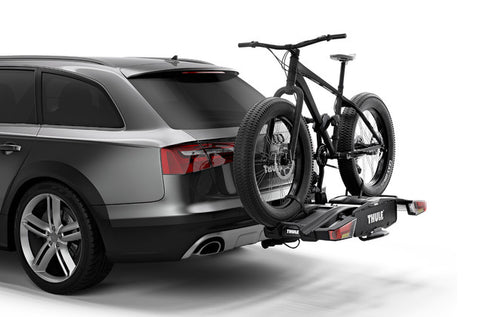
ck so you’ll want a rack with a swing-away motion or tilt function.
Also, consider what you will do with your rack in between uses - does it fold away easily for storage?
Mounting options and considerations:
- Towball or hitch receiver
- Wheel tray mount or frame grab (mast-style)
- 2 - 5 bike options
- Does it fold away for easy storage
- Swing or Tilt function for tailgate access
Advantages:
- Easy to mount bikes without too much lifting - potentially a ramp available
- Easy to mount and remove from vehicle
- Options for frameless contact with the bikes
- Carry up to 5 bikes of varying sizes
Disadvantages:
- Costly set up if you don’t already have a tow ball/hitch
- May also need to buy an accessory number plate or light bar
- No access or limited access to the trunk/boot while in use
Spare Wheel mounts:
For a vehicle with a spare wheel mounted to the rear tailgate, there may be an option specifically for your vehicle to mount bikes. These are normally limited to 2 bikes maximum and involve bolting onto the lug pattern of th
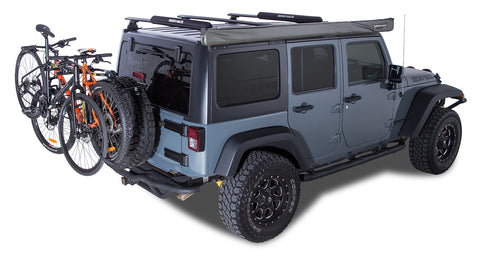
e wheel nuts or a hook/strap onto the spare tyre. These are very specific options in terms of what vehicles they fit but they are a good opti
on if they are available to you in terms of not interfering with access to the tailgate.
Ute Tray Mounts:
If you have a Ute you have another range of carriers available to you. Most Ute’s can utilise roof racks and also tow ball/hitch receiver mounts but there are also mounts available specifically for ute beds and their tailgates.

Tailgate “pads” are the simplest of the lot. They are simply a padded mat that hangs on the rear tailgate of the ute. The bikes then hook on with the front wheel hanging over the back of the tailgate. They are secured with straps to prevent them from moving during transit. The mats are made from super-tough fabrics and padding to prevent damage to the vehicle and bikes.
Ute Bed Adaptors. In most cases, these require removing the front wheel of the bike and securing the bike by the fork to ute bed or to an installed bar. These are normally permanent fits that require the adaptor to be drilled into the ute bed or wall of the tub.
They are super simple once installed, only requiring the wheel of the bike to be removed at the time of loading. Given it is a permanent mount, there is no need to store the carrier in between uses and you’re ready to go at a moment’s notice.
Accessories:
There are also accessories available to complete your set up. Some bikes require an adaptor for them to be compatible with mast-style rear-of-car carriers. Ladies bikes in particular usually need this adaptor.
Some tray-style bike carriers and racks have a compatible ramp so you can “drive” up the bike (by hand - please don’t ride your bike onto a carrier!) This is particularly important if you ever think you’ll use an e-bike as they are much heavier than standard bikes.
Remember we mentioned being compliant with local rules and regulations regarding number plate and warning light visibility? Well, you may need to purchase a number plate holder and/or light bar to attach to your rear-of-car rack. Some top-of-the-line rear-of-car bike racks already have these included.
Recapping, these are your important decision making questions…
- Top-of-car/ Rear-of-car?
- Do I want to install roof racks/tow ball/hitch or is there another option suitable (e.g. Strap-rack, spare wheel or Ute options)
- Do I care if the carrier or rack touches the bike frame? (Yes - then you need a tray or fork mount)
- How many bikes do I anticipate carrying?
- Is there anything unusual about my bike that will make it difficult to carry (e.g. extra-large, kids sizes, e-bikes).
- What other accessories will I need.

